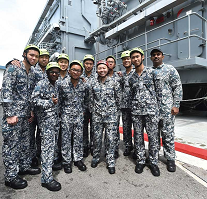WATER YOU WANT FROM ME
PHOTO // Chai Sian Liang
PIONEER journalist Benita Teo fights watery demons in the Navy's Damage Control Trainer (DCT).
Trainees call it the Baa Baa Black Ship. And the DCT was certainly a sight to behold.
What secrets could this massive, foreboding structure be hiding behind its windowless, dark metal walls?
Geared up in our suits of "armour" (Navy long four, hard hat, gloves and safety boots), my nine teammates and I were about to find out.
With over 20 training rooms, the DCT is able to simulate realistic scenarios of a ship in distress. It can roll a maximum of 15 degrees, imitating sea states of up to level four (where waves reach up to 2.5m high).
Suddenly, the sirens and red lights activated, signalling a state of emergency. The Ship began to rock from side to side. We knew the monster had awakened.
A water-breathing dragon
We dashed for the Engine Room, which had been "damaged" by enemy fire. Because the room was quickly flooding, we had to climb down through a hatch to prevent water from spilling out the doors.
Awaiting us was an angry waterfall bursting through gashes in one of the walls. It was as though a watery dragon had been unleashed.
I got to work plugging the holes with wooden pegs. This seemingly easy task quickly became frustrating - the torrent made it difficult to locate the holes and I was knocking blindly, trying to keep the water out of my eyes and the hammer off my fingers.
With some of the gashes plugged, we covered the site with a splinter box to slow down the flooding. Determining that an H Shore (see "Types of shores") was required to stem this leak, two of my teammates measured the length needed and set off to saw the beam.
The rest of us took turns holding up the splinter box. Although it weighed only 5kg, the barrage of water seemed to add kilogrammes every minute, and all seven of us were struggling to keep it in place.
By now, my arms were aching and I wanted to give up. But watching my team press on while patiently awaiting the others' return, I couldn't let them down.
Mr Brandon Lim, the instructor for our DCT assessment, reminded us we were lucky that freshwater was used in the simulator. Out at sea, we would be battling murky and even icy saltwater.
It was of small comfort as my teammate sputtered another mouthful of water into the pond I was now standing waist-deep in.
When the guys returned with the shoring wood, we hoisted the beam up against the ceiling. To lock it into position, my partner and I hammered two wedges between the beam and pad piece.
Finally, a horizontal shore was inserted between the beam and splinter box, and tightened with wedges to push the angry waterfall back.
Smiling 'cos it's over: me and my team, together with Firefighting and DC instructor ME3 Sugumaran (far right).
Water hell?
After that ordeal, I thought nothing else could faze me.
Oh, how wrong I was.
Our second assessment required us to tackle a high-pressure leak in the Front Mess. When the hatch opened, all we could see was a giant jet of water charging through the room.
It was like looking into the doorway of an underwater hell.
For a moment, I was paralysed; I'd never felt such unadulterated fear.
It took six guys pressed up against the splinter box to hold the water back. The rest of us quickly doubled up.
This time, instead of waiting for Mr Lim's guidance, we were stepping up to the tasks at hand. While some headed out for shoring wood, I repaired a "burst" overhead pipe with a pipe clamp. Our chemistry and confidence as a team had definitely improved.
I was given the responsibility of measuring and sawing the horizontal shore. But amid the chaos, it was difficult to accurately determine the distance between the box and vertical shore. I tried my best to measure and picked out a suitable length of wood.
For the Proud Shore structure we were building, the horizontal beam had to press directly against the vertical one, which stood at a 95-degree angle, resting against a strong point on the ceiling. I placed the shorter beam between the vertical shore and pad piece, and hammered it in place.
The beam slid down the centre of the box. Something was not right.
We tried again, adjusting centimetre by centimetre, but the beam still would not sit squarely. The watery assault continued and we were getting desperate - we had followed the procedure, so what was wrong?
Seeing that we had completed all the steps in the process, Mr Lim ended the exercise. He explained that I had under-measured the horizontal beam - I should have added at least a little finger's width (3 to 5mm) to the end of the measurement because the force of the leak would push the box further out, making the distance appear shorter.
I felt defeated as I had let my team down, but they were encouraging and supportive. While we were not completely successful, we had done our best and surmounted the challenges.
It had been no easy battle. And as we stood together, soaked to the bone, I knew this was the best adventure ever.










